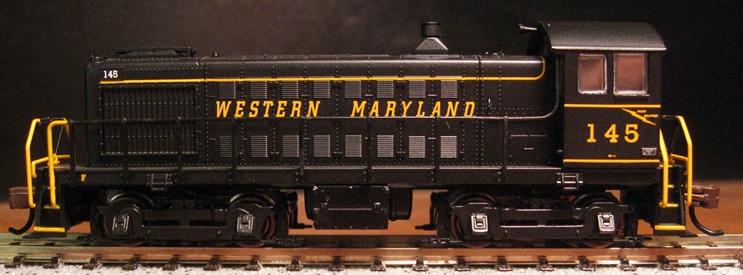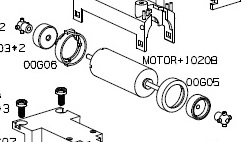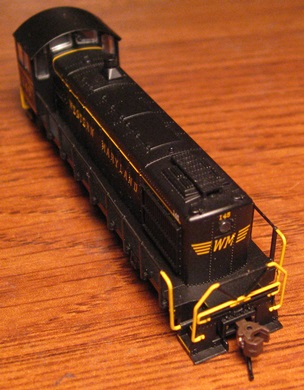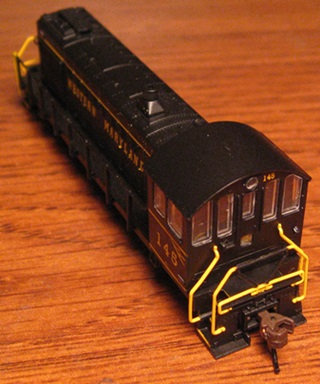

Introduced: 2013
Following closely on the heels of their outstanding 44 and 70-ton switchers, this equally outstanding Alco S-4 seems to represent Bachmann's attempt at completely monopolizing the N scale switcher market. And given the S-4's amazing performance (not to mention its reasonable price and DCC features), Bachmann might just have achieved that goal.
As pictured below, the mechanism is a fairly complex one. The chassis consists of a black metal base with a couple of separate grey metal weights screwed over the tops of the trucks. The fuel tank (et al) details are part of the metal base. The motor seats inside of a plastic saddle that is clip-fit to the chassis base. The decoder board is screwed to the top of the motor saddle -

LEDs on the decoder board provide white directional lighting, although the "as delivered" behavior of said lighting is a bit different from what we're used to from DCC-equipped locomotives. Rather than the "rear" light being off and the "forward" light being on (based on direction of travel), both lights are on all the time (with the rear light being a bit dimmer than the forward light). Unfortunately, there doesn't appear to be any way to change this basic behavior via decoder CV's (not based on what I'm seeing in the decoder docs on Bachmann's website, anyway). The only lighting-related CV's listed (51 and 52) relate to how "Rule 17" dimming works.
The motor itself is a round can (and thus different from the rectangular motors used in Bachmann's 44 and 70-tonners). My suspicion is that it is a variant on the round coreless motors used in Bachmann's 4-6-0 and 2-6-0 steamers (although, sorry, I am not going to tear mine apart in order to verify that theory). In any case, it is seriously quiet (no whine whatsoever). The small / hollowed-out discs on the ends of the driveshafts appear to be Bachmann's attempt at flywheels, but based on how abruptly the model drops down from full throttle, whatever affect they might have is pretty difficult to gauge.

All four axles are geared (black plastic gearing) and all eight wheels provide pickup (by way of wheelback wipers). Wires soldered to the wipers transfer current to the decoder board. The wheels are blackened and low-profile (no problems on Code-55 rails). There are no traction tires.

The shells are plastic and divided into two parts (the hood/sidesills and the cab). The base of the smokestack is part of the hood, whereas the round top is a separate press-fit piece. The handrails are on a par with Atlas and Kato (vis'a'vis their diameter), although the accent paint on the ends can cause them to appear a bit bloated in close-up photos (particularly when painted yellow). Nevertheless, I can assure you that measurements and side-by-side comparisons with similarly painted Atlas (et al) handrails prove that Bachmann's handrails are no fatter than anybody else's.


A separate black plastic shroud mounts inside of the cab (thus blocking out the windows and preventing the headlight LED from shining through them). Couplers are shell-mounted Bachmann E-Z Mates (aka "the boxing glove"). Ala-carte Rapido-style couplers are also included should you wish to go that route.

On the downside, the cab windows are glued in place (as is Bachmann's wont). Also, the shells lack handgrab and sidesill tread detail (ala their GP7 and RS-3 models of similar vintage). Still and all, these are very nice looking models with fine paint and decent detailing.
Performance is absolutely superb. Pickup is perfect (even through turnouts with non-powered frogs), throttle response is nimble, and overall running is as smooth as butter. And brother, are these things ever quiet! Apart from a slight electronic hum at extremely low throttle settings, these babies basically generate no noise at all. No problems on curves as sharp as 9.75" radius. Pulling power is decent (albeit unspectacular), with mine being able to comfortably haul about fifteen 40' freight cars through curves on flat track (any more than that though, and the wheels are slipping).
Whether it's due to the gearing or the motor (or maybe both), these models are definitely designed for switching (vis'a'vis their top-to-bottom speed range). They can creep along almost slower than the eye can detect at the low end of the throttle, whereas the top-end speed is equal to perhaps half-throttle on the other popular modern-day switchers (MP15, NW2, SW9, et al). Whether operated in DCC or DC mode, performance is essentially the same (with any variation being due to the max voltage of one's throttle / power supply). Given the model's relatively light weight, one does have to be pretty vigilant about keeping the track clean and shiny (otherwise they can get a bit balky). But apart from that, I guess my only real concern with these is the old-school pickup scheme (wipers and wires), which does make truck removal a bit more difficult than it could/should be. Overall though, these are nice looking and outstanding running models that have the added benefit of being both relatively inexpensive and decoder-equipped.
To remove the shell, insert a small screwdriver between the chassis and the sidesill and pry the shell upwards slightly. Once raised up from the base of the chassis, the shell should pull off readily.
Here's what Bachmann has to say about them -
Alco's 1,000-horsepower S4 switcher was the fourth entry in the company's highly successful "S" series of diesels. Now in N scale, Bachmann's DCC-equipped model adds digital control and versatility to your stable of locomotives. Performs best on 11.25" radius curves or greater.
Features -
- DCC-equipped for speed, direction, and lighting
- Dual-mode NMRA-compliant decoder
- Eight-wheel drive
- Precision can motor
- Dual, precision-balanced brass flywheels
- Finescale handrails
- Blackened nickel silver wheels
- NMRA wheel profile
- E-Z Mate Mark II couplers
Grade: A